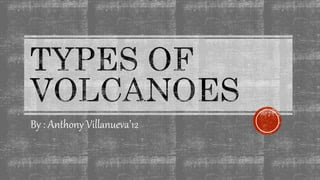Types of Volcanoes
•Download as PPTX, PDF•
4 likes•1,099 views
There are three main types of volcano - composite or strato, shield and dome. Composite volcanoes, sometimes known as strato volcanoes, are steep sided cones formed from layers of ash and [lava] flows. The eruptions from these volcanoes may be a pyroclastic flow rather than a flow of lava.
Report
Share
Report
Share

Recommended
Recommended
More Related Content
What's hot
What's hot (20)
Similar to Types of Volcanoes
Similar to Types of Volcanoes (20)
Intorduction to Volcanology, Weathering, Erotion, Dispertion and Soil.

Intorduction to Volcanology, Weathering, Erotion, Dispertion and Soil.
Recently uploaded
Antibiotics are medicines that fight infections caused by bacteria in humans and animals by either killing the bacteria or making it difficult for the bacteria to grow and multiply. Bacteria are germsABHISHEK ANTIBIOTICS PPT MICROBIOLOGY // USES OF ANTIOBIOTICS TYPES OF ANTIB...

ABHISHEK ANTIBIOTICS PPT MICROBIOLOGY // USES OF ANTIOBIOTICS TYPES OF ANTIB...ABHISHEK SONI NIMT INSTITUTE OF MEDICAL AND PARAMEDCIAL SCIENCES , GOVT PG COLLEGE NOIDA
Recently uploaded (20)
Module for Grade 9 for Asynchronous/Distance learning

Module for Grade 9 for Asynchronous/Distance learning
Cot curve, melting temperature, unique and repetitive DNA

Cot curve, melting temperature, unique and repetitive DNA
POGONATUM : morphology, anatomy, reproduction etc.

POGONATUM : morphology, anatomy, reproduction etc.
Use of mutants in understanding seedling development.pptx

Use of mutants in understanding seedling development.pptx
Porella : features, morphology, anatomy, reproduction etc.

Porella : features, morphology, anatomy, reproduction etc.
Cyathodium bryophyte: morphology, anatomy, reproduction etc.

Cyathodium bryophyte: morphology, anatomy, reproduction etc.
Thyroid Physiology_Dr.E. Muralinath_ Associate Professor

Thyroid Physiology_Dr.E. Muralinath_ Associate Professor
ABHISHEK ANTIBIOTICS PPT MICROBIOLOGY // USES OF ANTIOBIOTICS TYPES OF ANTIB...

ABHISHEK ANTIBIOTICS PPT MICROBIOLOGY // USES OF ANTIOBIOTICS TYPES OF ANTIB...
Understanding Partial Differential Equations: Types and Solution Methods

Understanding Partial Differential Equations: Types and Solution Methods
FAIRSpectra - Enabling the FAIRification of Analytical Science

FAIRSpectra - Enabling the FAIRification of Analytical Science
Types of Volcanoes
- 1. By : Anthony Villanueva’12
- 2. A volcano is a mountain that opens downward to a pool of molten rock below the surface of the earth. When pressure builds up, eruptions occur. Gases and rock shoot up through the opening and spill over or fill the air with lava fragments.
- 3. When magma erupts at the surface it can form different types of volcanoes depending on the viscosity, or stickiness, of the magma, the amount of gas in the magma, and the way in which the magma reached the surface.
- 4. Composite volcanoes are constructed from multiple eruptions, sometimes recurring over hundreds of thousands of years, sometimes over a few hundred. Andesite magma, the most common but not the only magma type forming composite cones, produces lava more brittle than basaltic lava because of its higher viscosity. Although andesitic composite cones are constructed dominantly of fragmental debris, some of the magma intrudes the cones as dike or sills
- 5. Cinder cones are mounds of basaltic scoria that forms by streaming gases that carry lava blobs and ribbons into the atmosphere to form lava fountains. The lava blobs commonly solidify during flight through the air before landing on the ground. If gas pressure drops, the final stage of building a cinder cone may be a lava flow that breaks through the base of the cone. If there is abundant water in the environment, magma interacts with water to build a maar volcano rather than a cinder cone.
- 6. Shield volcanoes are large volcanic forms with broad summit areas and low-sloping sides (shield shape) because the extruded products are mainly low viscosity basaltic lava flows. A good example of a shield volcano is the Island of Hawaii (the "Big Island"). The Big Island is formed of five coalesced volcanoes of successively younger ages, the older ones apparently extinct.
- 8. Hebrews 13:16 “And do not forget to do good and to share with others, for with such sacrifices God is pleased.”
